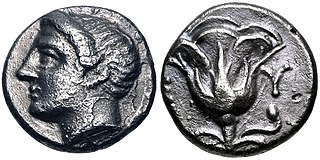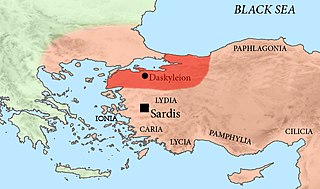
This article concerns the period 409 BC – 400 BC.
This article concerns the period 359 BC – 350 BC.
This article concerns the period 339 BC – 330 BC.

Year 333 BC was a year of the pre-Julian Roman calendar. At the time, it was known as the Year of the Dictatorship of Rufinus. The denomination 333 BC for this year has been used since the early medieval period, when the Anno Domini calendar era became the prevalent method in Europe for naming years.
Year 340 BC was a year of the pre-Julian Roman calendar. At the time it was known as the Year of the Consulship of Torquatus and Mus. The denomination 340 BC for this year has been used since the early medieval period, when the Anno Domini calendar era became the prevalent method in Europe for naming years.

The Battle of Issus occurred in southern Anatolia, on 5 November 333 BC between the Hellenic League led by Alexander the Great and the Achaemenid Empire, led by Darius III. It was the second great battle of Alexander's conquest of Asia, and the first encounter between Darius III and Alexander the Great. The battle resulted in the Macedonian troops defeating the Persian forces.

Antipater was a Macedonian general and statesman under the successive kingships of Philip II of Macedon and his son, Alexander the Great. In the wake of the collapse of the Argead house, his son Cassander would eventually come to rule Macedonia as a king in his own right.

Ochus, known by his dynastic name Artaxerxes III, was King of Kings of the Achaemenid Empire from 359/58 to 338 BC. He was the son and successor of Artaxerxes II and his mother was Stateira.

The wars of Alexander the Great were a series of conquests carried out by Alexander the Great of Macedon from 336 to 323 BC. They began with battles against the Achaemenid Empire, then under the rule of Darius III. After Alexander's chain of victories, he began a campaign against local chieftains and warlords that stretched from Greece to as far as the region of Punjab in South Asia. By the time he died, Alexander ruled over most regions of Greece and the conquered Achaemenid Empire, including much of Achaemenid Egypt; he did not, however, manage to conquer the Indian subcontinent in its entirety according to his initial plan.

Memnon of Rhodes was a prominent Rhodian Greek commander in the service of the Achaemenid Empire. Related to the Persian aristocracy by the marriage of his sister to the satrap Artabazus II, together with his brother Mentor he served the Persian king for most of his life, and played an important role during the invasion of Alexander the Great and the decades before that.

Ada of Caria was a member of the House of Hecatomnus and ruler of Caria during the mid-4th century BC, first as Persian Satrap and later as Queen under the auspices of Alexander III of Macedon.
Mentor of Rhodes was a Greek mercenary and later Satrap of the Asiatic coast. He fought both for and against Artaxerxes III of Persia. He is also known as the first husband of Barsine, who later became a mistress to Alexander the Great.
Orontobates was a Persian, who married the daughter of Pixodarus, the usurping satrap of Caria, and was sent by the king of Persia to succeed him.

Pixodarus or Pixodaros, was a satrap of Caria, nominally the Achaemenid Empire Satrap, who enjoyed the status of king or dynast by virtue of the powerful position his predecessors of the House of Hecatomnus created when they succeeded the assassinated Persian Satrap Tissaphernes in the Carian satrapy. Lycia was also ruled by the Carian dynasts since the time of Mausolus, and the name of Pixodarus as ruler appears in the Xanthos trilingual inscription in Lycia.

Artabazos II was a Persian general and satrap of Hellespontine Phrygia. He was the son of the Persian satrap of Hellespontine Phrygia Pharnabazus II, and younger kinsman of Ariobarzanes of Phrygia who revolted against Artaxerxes III around 356 BC. His first wife was an unnamed Greek woman from Rhodes, sister of the two mercenaries Mentor of Rhodes and Memnon of Rhodes. Towards the end of his life, he became satrap of Bactria for Alexander the Great.

Barsine was the daughter of a Persian father, Artabazus, satrap of Hellespontine Phrygia, and a Greek Rhodian mother, the sister of mercenaries Mentor of Rhodes and Memnon of Rhodes. Barsine became the wife of her uncle Mentor, and after his death married her second uncle, Memnon.

The Hecatomnid dynasty or Hecatomnids were the rulers of Caria and surrounding areas c. 395 – c. 330 BCE. They were satraps (governors) under the Achaemenid Empire, although they ruled with considerable autonomy as a hereditary dynasty. The dynasty had previously ruled the city of Mylasa, which became the capital of Hecatomnus, the first indigenous satrap of Caria. The dynastic capital was moved to Halicarnassus by Mausolus and Artemisia, who built the Mausoleum at Halicarnassus, one of the Seven Wonders of the Ancient World, there. The dynasty survived the conquest of the Achaemenid Empire by Alexander the Great when Ada I, the final Hecatomnid ruler of Caria, adopted Alexander the Great as her son. The small family was remarkable for containing so many sets of married siblings.

The siege of Halicarnassus was fought between Alexander the Great and the Achaemenid Persian Empire in 334 BC. Alexander, who had no navy, was constantly being threatened by the Persian navy. It continuously attempted to provoke an engagement with Alexander, who would not oblige them. Eventually, the Persian fleet sailed to Halicarnassus, in order to establish a new defense. Ada of Caria, the former queen of Halicarnassus, had been driven from her throne by her younger brother Pixodarus of Caria. When Pixodarus died, Persian King Darius had appointed Orontobates satrap of Caria, which included Halicarnassus in its jurisdiction. On the arrival of Alexander in 334 BC, Ada, who was in possession of the fortress of Alinda, surrendered the fortress to him.

Pharnabazus III was a Persian satrap who fought against Alexander the Great. His father was Artabazos II, and his mother a Greek from Rhodes.

Arsites was Persian satrap of Hellespontine Phrygia in the Achaemenid Empire in the 4th century BC. His satrapy also included the region of Paphlagonia.















